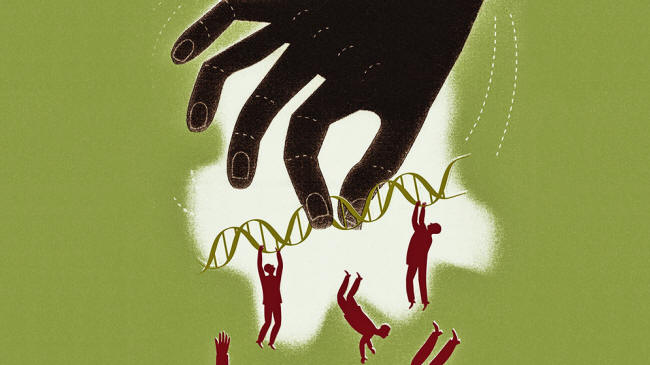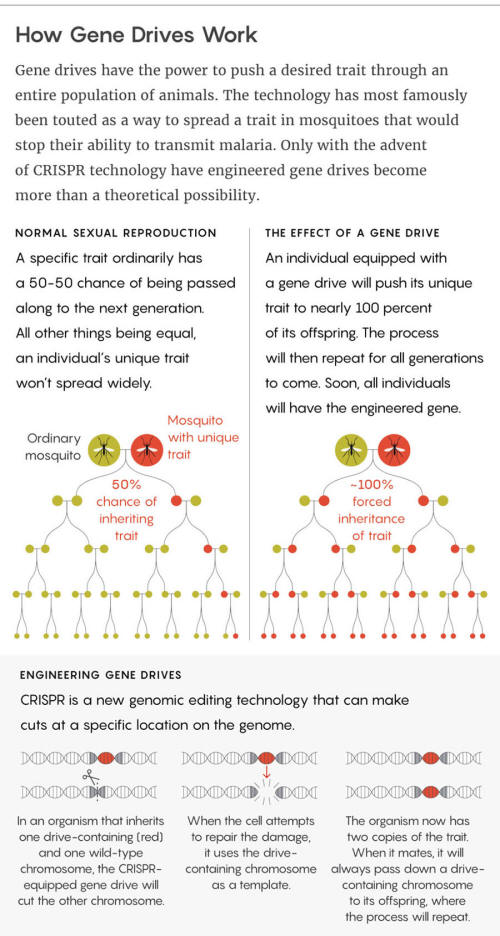|

by Brooke Borel
November 16,
2017
from
QuantaMagazine website

In the ongoing controversy over
whether
and how to use a powerful new
genome
editing technology in the wild
to
achieve conservation and public health goals,
two new
papers urge caution.
Andy Baker
Two new
papers urge caution
in using
powerful genome-editing technology
against invasive
species:
Models show that
evolving resistance
won't stop
aggressive
standard gene
drives
from spreading.
As the revolutionary
CRISPR technology for modifying
genomes has taken off in recent years, one daring potential
application has caught the attention of conservation scientists,
policymakers, public health workers and others:
It could be used to
create so-called
gene drives to eliminate or
control unwanted species.
Experts debating the
wisdom or perils of that approach have often reached very different
answers.
A new paper being published today makes a case that caution is
warranted. Using computer modeling, it suggests that in at least
some forms, the drives may be more invasive than previously
suggested.
The paper (Current
CRISPR gene drive systems are likely to be highly invasive in wild
populations) is now on the scientific preprint site
biorxiv.org.
(The authors, a team from
Harvard University and the Massachusetts Institute of Technology,
also submitted the work to a peer-reviewed journal.)
Gene drives are genetic constructions that can be inserted
into DNA to change the rules of inheritance in sexual reproduction.
They can boost the chances that a particular trait will pass from a
parent to its offspring from 50-50 to nearly 100 percent.
The technology is so far
limited to the lab, but many scientists hope to eventually use it to
control disease-carrying insects, invasive species and other
problematic organisms.
That ambition has met with two kinds of resistance:
-
One is from other
researchers and environmentalists who worry that gene drives
might become invasive, spreading unintentionally far in
nature with undesired effects.
-
The other is from
the natural world itself:
As we
reported last year (Genetic
Engineering to Clash With Evolution), a
series of papers suggested that organisms evolving
resistance to gene drives might stop them from going
very far in the wild.
The new modeling work
from Harvard and MIT, however, finds that the most basic version of
a gene drive - one with CRISPR technology, meant to replicate and
spread indefinitely - may be invasive even in the face of
evolutionary resistance.
In the new paper,
"invasive
means that if even a small number of organisms with a gene drive
are released to a large wild population, it's likely that the
drive element could spread within that population and to
neighboring populations," said Charleston Noble, a doctoral
student at Harvard and a first author.
In an accompanying
perspective published today at PLOS Biology,
Kevin Esvelt, an evolutionary
engineer at MIT, and
Neil Gemmell, a geneticist at
the University of Otago in New Zealand, outline what's at stake with
standard gene drives - particularly for conservation projects.
The perspective also calls for more research on local gene drives -
including an untested approach promoted by Esvelt's lab - that would
work somewhat like a standard drive but with biological limits that
make them less likely to spread outside targeted populations.
Esvelt says the perspective serves in part to correct statements in
a paper (Emerging
Technology - Concerning RNA-guided gene drives for the alteration of
wild populations) he co-authored in 2014, which he now
thinks were too optimistic about the potential for standard gene
drives in conservation.
"We're hoping to shed
more light on the topic and make it very clear that my earlier
decision to list environmental conservation" as a use "for
standard gene drives is a mistake," he said.
"Unless you are doing
a [local] drive technique, it'll be a problem."
Real World
Data in Gene Drive Models
In the modeling preprint, the Harvard and MIT team only considered
one type of standard gene drive, called a replacement or alteration
drive.
Here, the drive swaps out
a trait in a population.
For example, a
replacement drive might alter Anopheles mosquitoes so that they
can't physically transmit the malaria parasite.
The model also ignored a range of factors that could curb the spread
of a gene drive in the wild, including the distance between
populations, differences in local ecology and any inability for lab
organisms to mate with their wild counterparts.

Lucy Reading-Ikkanda
Quanta
Magazine
This simplicity was "deliberate," said
Charleston Noble.
"We wanted to err on
the side of caution and keep it as simple as we could. Adding
more factors could make [the gene drive] look better from a
containment standpoint."
The paper included two
main models.
-
The first assumed
a large population of organisms in which any individual was
equally likely to mate with any other.
-
The second broke
the population into smaller groups, and individuals could
migrate between them.
Both models included a
mix of wild-type organisms (ones with naturally occurring genomes),
as well as those with gene drives or resistance to the gene drives.
To get a sense of how efficient the gene drives might be in reality
- and how much resistance they'd face - the team pulled data from
published gene-drive experiments in fruit flies, mosquitoes and
yeast.
The results suggest that releasing even a small number of gene-drive
organisms can be invasive. This was true for even the least
effective gene drives - and in the presence of resistance.
In one modeled scenario
involving a gene drive that was only conservatively efficient, for
example, releasing just 10 organisms created a 97 percent chance of
invasion, which spread the drive out to a third of the population on
average.
But the models didn't consider the gene drives that most
scientists think are more likely to be used in conservation
projects:
suppression drives.
In those, the gene drive
alters a trait that the population needs to survive.
For example, such a drive
may skew a population to be all male or all female so it stops
breeding and dies out. It's unclear whether suppressive drives would
prove as invasive, although Noble said he plans to investigate these
soon.
That the new models look at migration between subpopulations is
important because it is,
"something people so
far haven't taken into account," said
Philipp Messer, a population
geneticist at Cornell University who was not involved in the
research.
Plugging experimental
data back into the models is also a new step for gene drives.
Although the findings
aren't particularly surprising, he added, it's hard to tell how well
they model the real world because they are so simplified.
According to the modeling paper, the findings call into question
recommendations from a 2016 report from the National Academies of
Science, Engineering, and Medicine.
The report (Gene
Drives on the Horizon) was cautious on gene drives and
recommended more research - including controlled field tests.
The Harvard and MIT team,
however, argue that even controlled field tests may pose a problem
for standard gene drives.
Among those who disagree with their assessment is Jason Delborne,
one of the authors of the 2016 report and a professor of science,
policy and society at North Carolina State University.
While the 2016 report did
suggest a stepwise approach to field tests, the authors,
"concluded that not
enough was known to pursue an environmental release," Delborne
wrote by email.
"Arguably that has not changed," he added. "Unfortunately, the
term 'field trial' is not a precise concept, because its degree
of risk depends upon the specifics of the technology and its
context."
Your Friendly
Neighborhood Gene Drive
In the PLOS perspective paper, Esvelt and Gemmell outlined the
broader implications for standard gene drives in conservation
projects - particularly those that aim to eliminate invasive
rats, mice and other mammals from islands.
The paper highlighted alternative gene-drive technologies that could
spread a gene to a population but not beyond that population.
One example is a
precision gene drive, which targets a version of a gene that is
unique to a population.
For example, invasive
mice that live on an island may have been isolated from mainland
mice long enough to have some unique genetic features, even though
they are still the same species.
A gene drive targeted at
that feature would work on the island, but not on other mice.
Another idea, which is so far untested, is from Esvelt's lab. He
calls it the daisy drive, which essentially breaks a gene
drive into separate but interacting pieces, like links in a
daisy chain.
It would be,
"kind of like a
genetic multiple-stage booster rocket," Esvelt said.
Whereas a standard gene
drive inserts a copy of itself into its partner chromosome, the
pieces of a daisy drive each help to copy the next piece into a
chromosome, although one piece by design does not get help from
others.
Eventually, as pieces
drop out of the population, the drive stops being able to spread to
new generations.
The PLOS perspective was meant to provoke discussion, Gemmell said
by email.
"We are not against
gene-drive technology per se," he wrote.
Gene drives are an,
"important future
solution to a variety of problems in the conservation domain.
But they need to be controllable in some context if we are to
seriously consider redeployment in an environmental context."
But while caution is
vital to gene drive research, it's nothing new, said Fred Gould,
an entomologist and co-director of North Carolina State's Genetic
Engineering and Society Center.
"It seems to me that
people are being careful," he said, referring to the handful of
research groups exploring gene drives for conservation.
Two of these groups -
Predator Free 2050 in New
Zealand and
GBIRd in the U.S., Australia
and New Zealand - are already exploring local gene drives as well as
plans for communicating with local communities about potential risks
and benefits.
Gould also stressed that,
so far, gene-drive research is in the early stages - nowhere near
ready for field tests - and it's unclear how the drives will truly
behave in practice.
Looking into the future
is important, but so too is recognizing what people are actually
doing, he added.
"I don't think we
should get ahead of ourselves here."
| 


